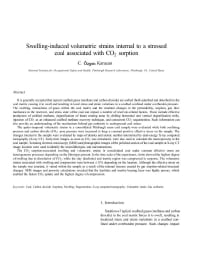Mining Publication: Swelling-Induced Volumetric Strains Internal to a Stressed Coal Associated with CO2 Sorption
Original creation date: November 2007
Authors: C Karacan
NIOSHTIC2 Number: 20032850
Int J Coal Geol 2007 Nov; 72(3-4):209-220
It is generally accepted that typical coalbed gases (methane and carbon dioxide) are sorbed (both adsorbed and absorbed) in the coal matrix causing it to swell and resulting in local stress and strain variations in a coalbed confined under overburden pressure. The swelling, interactions of gases within the coal matrix and the resultant changes in the permeability, sorption, gas flow mechanics in the reservoir, and stress state of the coal can impact a number of reservoir-related factors. These include effective production of coalbed methane, degasification of future mining areas by drilling horizontal and vertical degasification wells, injection of CO2 as an enhanced coalbed methane recovery technique, and concurrent CO2 sequestration. Such information can also provide an understanding of the mechanisms behind gas outbursts in underground coal mines. The spatio-temporal volumetric strains in a consolidated Pittsburgh seam coal sample were evaluated while both confining pressure and carbon dioxide (CO2) pore pressure were increased to keep a constant positive effective stress on the sample. The changes internal to the sample were evaluated by maps of density and atomic number determined by dual-energy X-ray computed tomography (X-ray CT). Early-time images, as soon as CO2 was introduced, were also used to calculate the macroporosity in the coal sample. Scanning electron microscopy (SEM) and photographic images of the polished section of the coal sample at X-ray CT image location were used to identify the microlithotypes and microstructures. The CO2 sorption-associated swelling and volumetric strains in consolidated coal under constant effective stress are heterogeneous processes depending on the lithotypes present. In the time scale of the experiment, vitrite showed the highest degree of swelling due to dissolution of CO2, while the clay (kaolinite) and inertite region was compressed in response. The volumetric strains associated with swelling and compression were between ±15% depending on the location. Although the effective stress on the sample was constant, it varied within the sample as a result of the internal stresses created by gas sorption-related structural changes. SEM images and porosity calculations revealed that the kaolinite and inertite bearing layer was highly porous, which enabled the fastest CO2 uptake and the highest degree of compression.

NIOSHTIC2 Number: 20032850
Int J Coal Geol 2007 Nov; 72(3-4):209-220
- A CART Technique to Adjust Production from Longwall Coal Operations under Ventilation Constraints
- Coal Mine Methane: A Review of Capture and Utilization Practices with Benefits to Mining Safety and to Greenhouse Gas Reduction
- Degasification System Selection for U.S. Longwall Mines Using an Expert Classification System
- Drainage of Methane From the Overlying Pocahontas No. 4 Coalbed From Workings in the Pocahontas No. 3 Coalbed
- Historical Development of Technologies for Controlling Methane in Underground Coal Mines
- Methane Control by Isolation of a Major Coal Panel - Pittsburgh Coalbed
- Methane Gas Content of the Mary Lee Group of Coalbeds, Jefferson, Tuscaloosa, and Walker Counties, Ala.
- A Review of the Mechanisms of Gas Outbursts in Coal
- Rotary Drilling Techniques Used in the Beckley Coalbed
- Underground Gob Gas Drainage During Longwall Mining